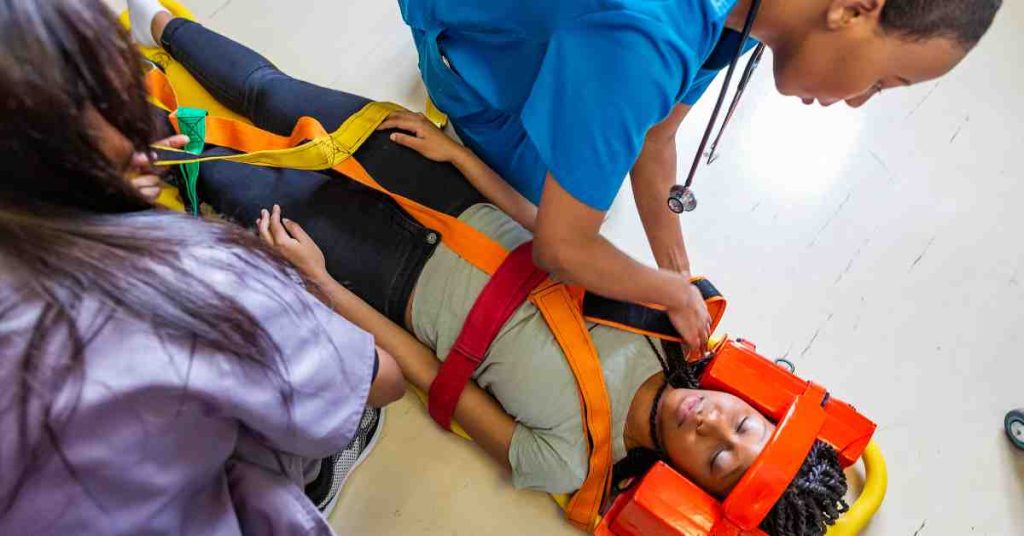First Aid, Assessment and Responding to Head and Spinal Injuries

Given the severe and lasting effects that head and spinal injuries can have on a person’s health, dealing with their consequences requires promptness, accuracy, and knowledge of the situation.
These serious injuries are alarmingly frequent; according to reports, Approximately 20,800 Australians are living with a spinal cord injury.
Such injuries occur frequently and are caused by a variety of events, including workplace accidents, car accidents, sports-related accidents, which account for about 8% of all spinal cord injuries, and vehicular accidents, which account for about 39.3% of these severe cases.
This blog post is crafted as an essential guide, focusing on providing comprehensive insights into the proper assessment and immediate response protocols for head and spinal injuries. Our objective is to deepen your understanding and competence in handling these emergencies, underscoring preventative measures, and thereby fostering a safer environment for all.
Understanding Head and Spinal Injuries
The human body is a complex, delicately balanced mechanism, with the skull and spine serving as critical components in this intricate system. The skull, housing the brain, acts as the fortress for the body’s command center, while the spine maintains structural support, anchors the nervous system, and facilitates mobility. These key components, however, are susceptible to injuries. The skull can suffer fractures and concussions, particularly vulnerable due to its position and minimal shielding. Similarly, the spine, composed of vertebrae, discs, and the spinal cord, faces risks like disc herniation, spinal cord damage, or vertebral fractures, often due to traumatic impacts, sudden movements, or falls.

The repercussions of injuries to these essential structures are profound, with potential short-term consequences including acute pain, loss of certain bodily functions, and psychological trauma. Long-term effects can be even more severe, extending to chronic pain, paralysis, cognitive impairment, or, in extreme cases, death.
These potential outcomes underscore the necessity for an immediate and knowledgeable response to head and spinal injuries. Rapid intervention can drastically reduce the severity of these consequences, preserve life quality, and in some scenarios, be the dividing line between life and death.
- Exploring the fundamental anatomy of the skull and spine, emphasizing their roles in overall bodily function.
- Detailing the specific parts and their purposes within the bodily system.
- Discussing common vulnerabilities and typical injuries associated with these crucial structures.
- Delving into the serious implications of head and spinal injuries on a person’s health and daily functioning.
- Outlining the short-term and long-term consequences of severe injuries.
- Highlighting the critical need for swift, appropriate responses to these emergencies, emphasizing the role of such interventions in altering the trajectory of recovery and rehabilitation.
Immediate Response to Suspected Head or Spinal Injury
In the crucial moments following a head or spinal injury, every action counts.
Immediate responders must employ on-the-scene assessment techniques, beginning with initial visual and verbal evaluations. Check for consciousness, coherence in speech, orientation, and visible signs of trauma such as bleeding or deformation. However, it’s equally vital to understand what not to do, such as unnecessarily moving the individual, as this can exacerbate potential spinal injuries or cause further harm.
Instead, first aid measures should focus on stabilizing the person, using techniques like keeping the head and neck aligned if a spinal injury is suspected, applying pressure to control bleeding, and providing reassurance to the injured party. Implement measures to prevent further injury, such as safeguarding the individual from additional dangers or falls.

Simultaneously, it’s paramount to seek professional medical assistance. Immediately call emergency services, providing clear, concise details about the injured person’s condition, the nature of the injury, and the current situation on the scene. Prepare to give specific information, such as if the person is conscious, the exact location of the incident, and any known pre-existing medical conditions. These decisive steps are integral in ensuring the injured receives professional care as swiftly as possible, potentially mitigating long-term complications.
- Conducting initial assessments at the scene with detailed visual inspections and communication tests to gauge the severity of the injuries.
- Guidelines on crucial non-actions to prevent exacerbation of the injuries.
- Executing vital first aid measures aimed at stabilizing the injured individual.
- Procedures and precautions necessary for preventing further complications or injury.
- Initiating immediate contact with professional medical providers.
- Delivering precise, essential information to emergency responders to expedite professional intervention.
- Emphasizing the role of these early actions in shaping the prognosis for the injured party, highlighting the gravity and impact of informed, prompt responses in such critical scenarios.
Preventative Measures and Safety Protocols
While an immediate response is crucial following head and spinal injuries, prevention remains the most effective strategy. This involves proactive measures, including the use of appropriate safety equipment like helmets in construction sites, sports, or cycling, and proper footwear to reduce the risk of slips or falls. Modifying environments to make them safer is also key; this includes installing non-slip surfaces in high-traffic or wet areas, ensuring walkways are clear of hazards, and employing proper lighting and handrails where necessary.

Moreover, the importance of education and training cannot be overstated. Comprehensive first aid training for both individuals and organizations is essential, equipping them with the knowledge to not only respond effectively to accidents but also to adopt practices that minimize risks.
Regular drills and information sessions help reinforce this knowledge, keeping safety protocols fresh and top of mind.
These preventative strategies collectively create safer environments, significantly reducing the likelihood of severe injuries, and ensuring preparedness should they occur.
- Implementing practical strategies for injury prevention:
- Usage of safety equipment specific to various activities or environments to minimize injury risk.
- Adaptation of surroundings, including crucial modifications to everyday environments, to enhance overall safety.
- Elevating the role of education and consistent training in injury prevention:
- Advocating for widespread first aid training, emphasizing its value for immediate response efficacy and injury prevention awareness.
- Establishment of regular safety drills and educational sessions, ensuring continuous awareness and readiness among individuals and groups.
- Highlighting the collective responsibility in adopting and advocating for these measures, contributing to the holistic safety of communities and individual well-being.
Recovery and Support After Head and Spinal Injuries
Emerging from the immediate aftermath of head and spinal injuries begins a potentially long and challenging journey toward recovery.
This phase is multifaceted, often starting with medical interventions that may involve surgery, medication, and possibly long-term rehabilitation, including physical, occupational, or speech therapy.
Survivors face a spectrum of challenges that aren’t just physical but also emotional, psychological, and social. These may include coping with mobility restrictions, changes in lifestyle, dependence on caregivers, or dealing with the psychological implications such as depression or anxiety.

In light of these challenges, robust support systems and resources are integral to the recovery journey. Professional counseling and support groups offer emotional healing and a community of empathy and understanding. They provide a platform for survivors to share experiences, learn coping strategies, and find encouragement.
Additionally, numerous community and online resources are available, offering everything from practical advice and financial guidance to forums for connection and advocacy opportunities.
These resources are invaluable for survivors and caregivers alike, offering support, education, and community as they navigate the complexities of recovery.
- Detailed insights into the recovery process post-injury:
- The varied medical interventions and rehabilitation efforts employed to facilitate physical recovery.
- Acknowledgment of the comprehensive challenges survivors face, spanning physical, emotional, and social aspects.
- The necessity of strong support networks and resources:
- The role of professional counseling and support groups in providing emotional fortitude and a sense of community.
- The availability and benefits of various community and online resources, offering practical support, solidarity, and advocacy for survivors and caregivers.
- Emphasizing the holistic approach to recovery, acknowledging that healing isn’t just physical and that comprehensive support systems are crucial for a meaningful return to well-being.
The First Aid Nest run public and workplace first aid courses, Australia wide.
Our workplace first aid courses can be run at your site.
Our public classes are here in Sydney and are the best option if you are an individual, a couple or a group
of just a few people.
Our sophisticated system will take the headache out of renewal for you too. Lose your certificate? No problem, just log in and download your certificate again anytime. We will also send you reminders about when your certificate is about to expire!
Book your spot or workplace with us today, contact us with any questions, or head to our FAQ page

